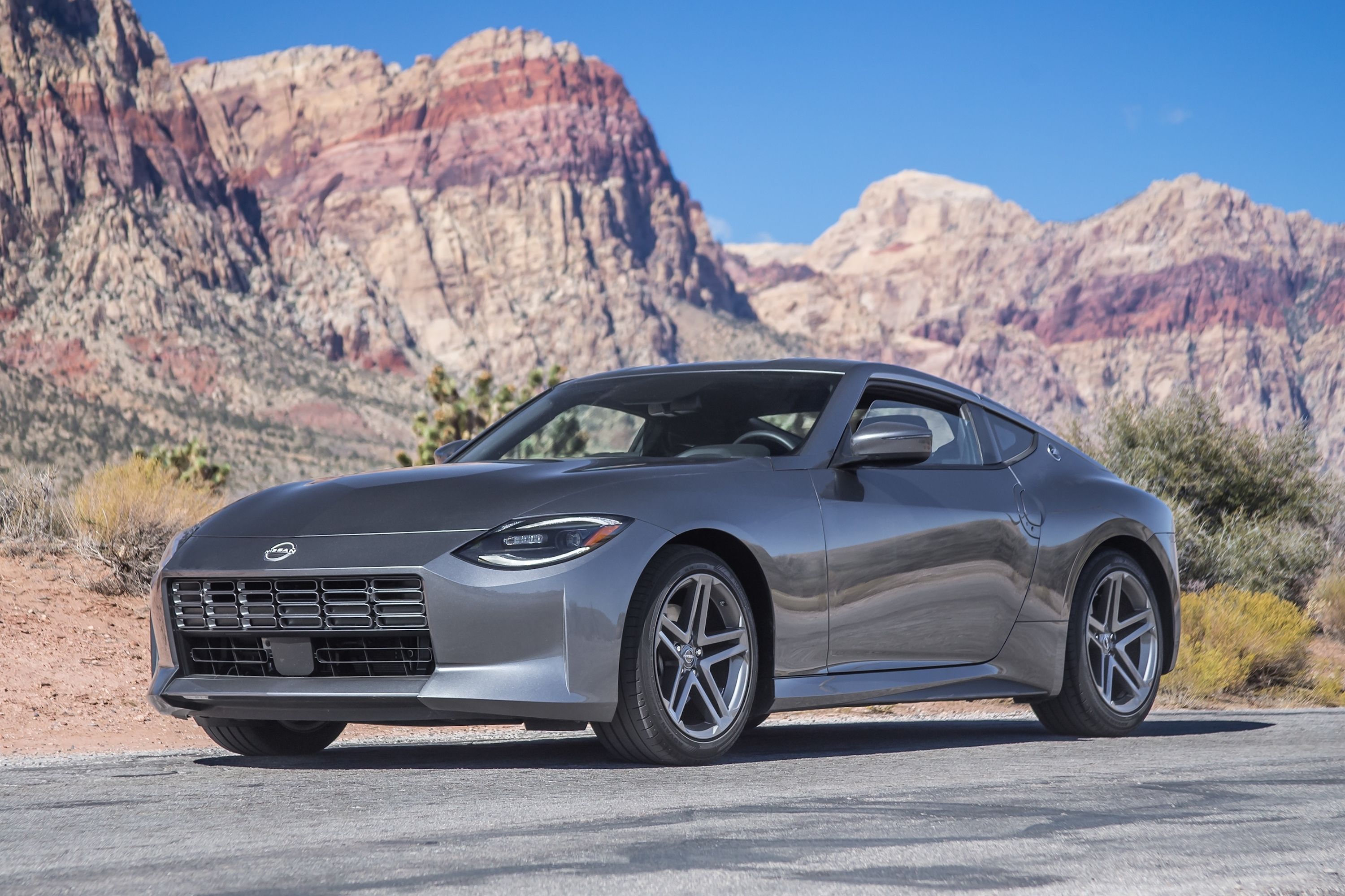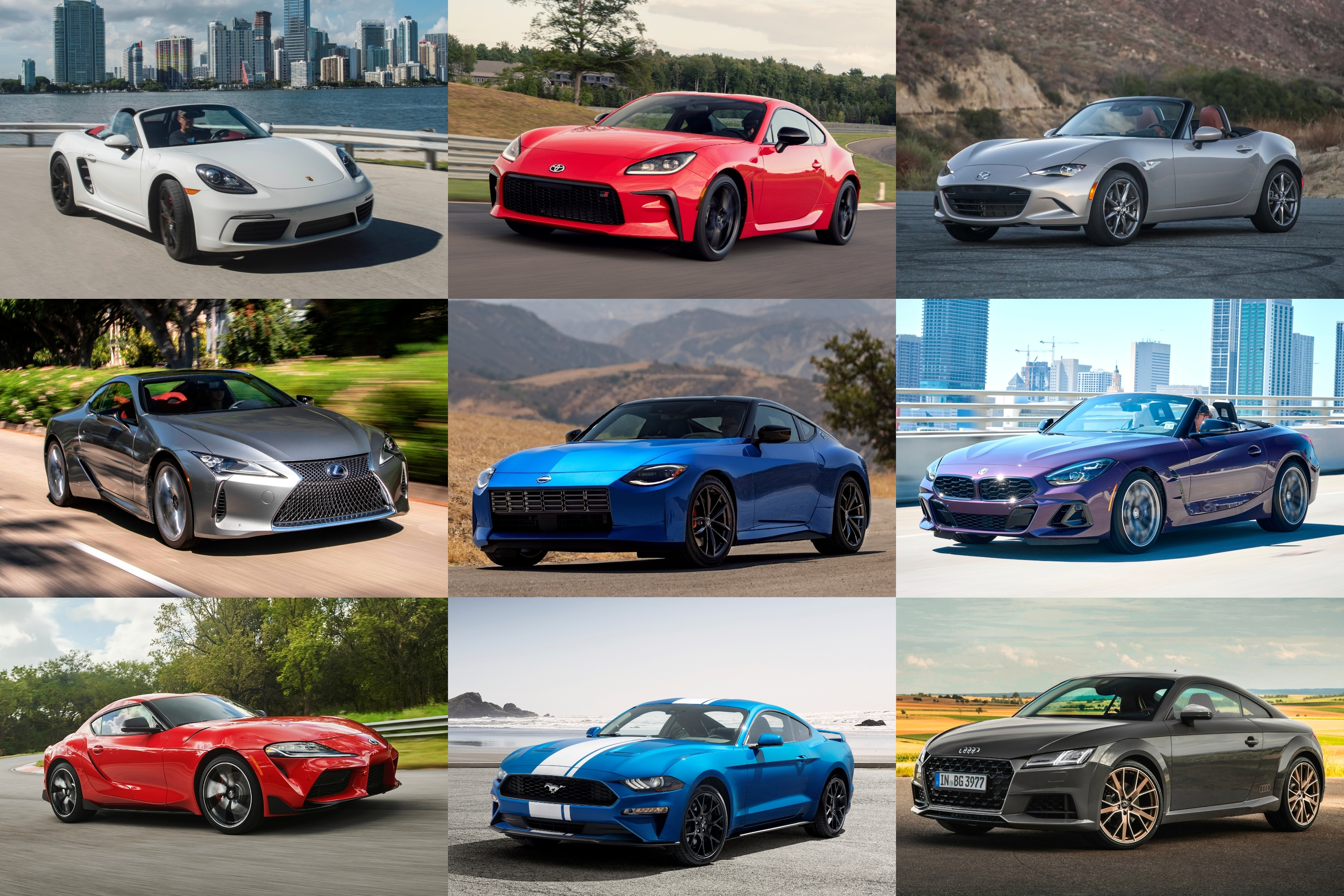
SUVs and crossovers are great; they serve their purpose as practical daily drivers and, for the most part, aren't too daunting to drive. However, deep down, you've always dreamed of cruising along the coastline with the top down or flying down the road in something sporty while everyone stares at your car. Although they don't always make sense, sports cars are cool and everyone feels the need to own at least one in their lifetime.
But even if practicality isn't a concern, amidst ever-rising gas prices, you may be less likely to drop the hammer in your shiny new 6.2-liter V8-powered sports car. But thanks to modern powertrain technologies, not all sports cars will drink your wallet dry. We've compiled a list of the 10 sports cars with the best fuel economy, according to the EPA's combined estimates, that will still put a smile on your face. And we haven't cheated you out of your combustion thrills either with EVs. All of these are powered by good ol' combustion, with only traditional hybrids considered - not plug-in hybrids with their confusing and unrealistic MPGe figures.
10. Nissan Z - 22 MPG
Entering the countdown at number 10, the new Nissan Z revives an iconic nameplate using an archaic chassis. But don't let that dissuade you; it's got modern power from a 3.0-liter twin-turbo V6 developing 400 horsepower and 350 lb-ft, only driving the rear wheels. Thanks to throwback styling, it looks timeless, and because it has boost behind it, you can hit 60 mph in 4.3 seconds with the nine-speed automatic gearbox. You may want the engagement of the manual, but you'll be a little slower, and you'll miss out on 22 mpg combined. That figure is only attainable with the auto, with the manual variant dropping to an even 20 mpg combined but still maintaining a reasonable 24 mpg on the highway.
9. Porsche 718 Boxster And Cayman - 24 MPG
Porsche is the undisputed king of sports cars. Any sports car it builds is golden to drive, rapid, comfortable, and liveable. And, they can be light on gas, too, especially when looking at the base 2.0-liter, turbo four-cylinder 718 Cayman and Boxster duo.
It might just have an engine size comparable to an Audi A3, but that doesn't mean it slacks off. These cars have 300 hp on tap, paired with a mid-mounted engine and rear-wheel drive, making them rapid - 0-60 mph in 4.9 seconds sort of rapid. But despite this, you get hot-hatchback fuel economy with 24 mpg combined whether you opt for a coupe or a convertible - matching the economy of a Toyota GR Corolla.
8. Toyota GR86/Subaru BRZ - 25 MPG
A car that still has enthusiasts rather confused, the GR86 and its Subaru BRZ twin are entry-level sports cars. They are often bemoaned for "not having enough power," but these are intended to rival the Miata, not bigger, badder sports cars. The new 2.4-liter engine has also remedied much of the duo's performance deficit with 228 hp and hasn't robbed the sports cars of their relatively fuel-efficient drive. But the 25 mpg figure above is only attainable with the six-speed automatic gearbox. While it isn't bad, it somewhat defeats the point of these cars. But, the six-speed manual is vastly less efficient and only bags these cars a combined rating of 22 mpg.
7. Chevrolet Camaro - 25 MPG
Another not-so-muscular muscle car, the Chevrolet Camaro 2.0-liter guise has two fewer cylinders than the Charger we mentioned earlier, making it even less of a gas guzzler. This may be the base engine within the Camaro range, but that doesn't mean it's not a good sports car.
With the eight-speed automatic transmission, the four-cylinder engine averages 25 mpg while still producing a healthy 275 hp, and it looks good doing it. Plus, you get the exceptional chassis of the Camaro, making this a fine sports car to drive, even if the interior is a little cramped. The sixth-gen Camaro is dead at the end of next year, and we don't know if it'll be replaced anytime soon, so enjoy it while you still can.
6. Ford Mustang EcoBoost - 25 MPG
What's the difference between a muscle car and a pony car? That may be a bigger debate for another day, but we'd wager one criterion that separates the two is engine displacement, and with a 2.3-liter turbo four-cylinder, the base Mustang EcoBoost is a definite pony car icon. Under the hood, said turbocharged four-cylinder generates either 310 hp and 350 lb-ft or an extra 20 hp with the High Performance Package. Available with both a six-speed manual and a 10-speed automatic gearbox, it'll hit 60 mph in just 5.1 seconds. And, with the automatic gearbox, you'll still manage a combined average of 25 mpg. The manual drops this to 25 mpg.
5. Audi TT - 25 MPG
It's gone by many nicknames, called a hairdresser's car by some and a miniature R8 by others, but in any incarnation, the Audi TT has been a style icon. Sadly, that's no longer to be the case, as the TT is about to be culled and won't be replaced, but that doesn't mean you can't still get a 2023 model, which is pretty efficient.
The car tested by the EPA had a 2.0-liter turbocharged engine producing 228 hp, paired to a seven-speed dual-clutch automatic. Built around similar underpinnings to the VW Golf, the MQB platform and TFSI engine endow the TT with impressive fuel economy when you're light on the gas, consuming 25 mpg combined despite a 5.2-second 0-60 mph time also being attainable. You can get even more powerful trims, such as the TT S and the five-cylinder-powered TT RS, but those won't produce quite the same fuel economy as the standard variant.
4. Toyota GR Supra - 28 MPG
The Supra receives lots of hate for two reasons. One, it hadn't evolved like some of its old rivals had (Nissan took the GT-R nameplate and turned it into a supercar, for example), and two, a lot of the car was built from BMW parts. Although somewhat relevant statements, time has changed the opinions of many, and it's generally accepted that the Supra stayed true to its sports car form and that the joint venture with BMW is to be praised for saving a sports car icon. That BMW influence has also paid dividends regarding gas mileage, as Bimmer's turbocharged power plants are remarkably efficient.
The 28 mpg figure above applies to the 2.0-liter turbo-four, but even with the B58 inline-six and its 382 hp, you can still manage 26 mpg with the eight-speed automatic.
3. BMW Z4 - 28 MPG
Remember the BMW we spoke about earlier that was essentially the same car as the Supra? Well, this is it, but you knew that already. Also available with either a turbocharged 2.0-liter four-pot or 3.0-liter six-cylinder, the Z4 is naturally most efficient with the weaker motor, consuming 28 mpg combined. But even the 382-hp six-cylinder isn't atrocious and will sip away at 26 mpg combined in M40i guise.
The Z4 is for the more brand-oriented sports car enthusiast, one looking to hit the road with the top down on occasion. It may not be our favorite BMW Z-car around, but if you're looking for a sports car that's light on the wallet, this is one of the best.
2. Lexus LC 500h - 29 MPG
This is the only hybrid on this list, and while some may call this a grand tourer rather than a sports car, we're inclined to say its four seats don't make it less of a sports car any more than the Porsche 911's four seats discredit it as one. The LC is still a sports car, and a mighty stylish one at that, and in LC 500h form, it's super efficient too, thanks to a hybrid 3.5-liter V6 producing 354 horsepower but also only consuming 29 mpg combined. Despite it being super-frugal, it's pretty damn quick, hitting 60 mph in 4.7 seconds, and makes the list of 10 fastest Lexus models with a top speed of 155 mph. It may be the most expensive car on this list, but that's not what we're looking at today; this is still a fuel-efficient sports car.
1. Mazda MX-5 Miata - 30 MPG
Small, lightweight, affordable, and timeless. The Mazda MX-5 Miata has been adored by gearheads the world over since it was revealed in 1989. The MX-5 proves that power isn't everything, and a fun car can come from a perfect chassis and light curb weight.
Being lightweight and housing a relatively small engine, it's no surprise that the little Japanese droptop manages such impressive fuel economy. But there is a caveat to the 30 mpg combined you see here, as that's only available with the six-speed automatic gearbox, and a Miata with an automatic is really not the model you should be buying. Fortunately, the manual isn't much worse, and figures of 26/34/29 mpg city/highway/combined are attainable. In a front-engine, rear-wheel-drive car that can do 0-60 mph in six seconds, that's no mean feat, and its good gas mileage just makes the Miata even more desirable.

